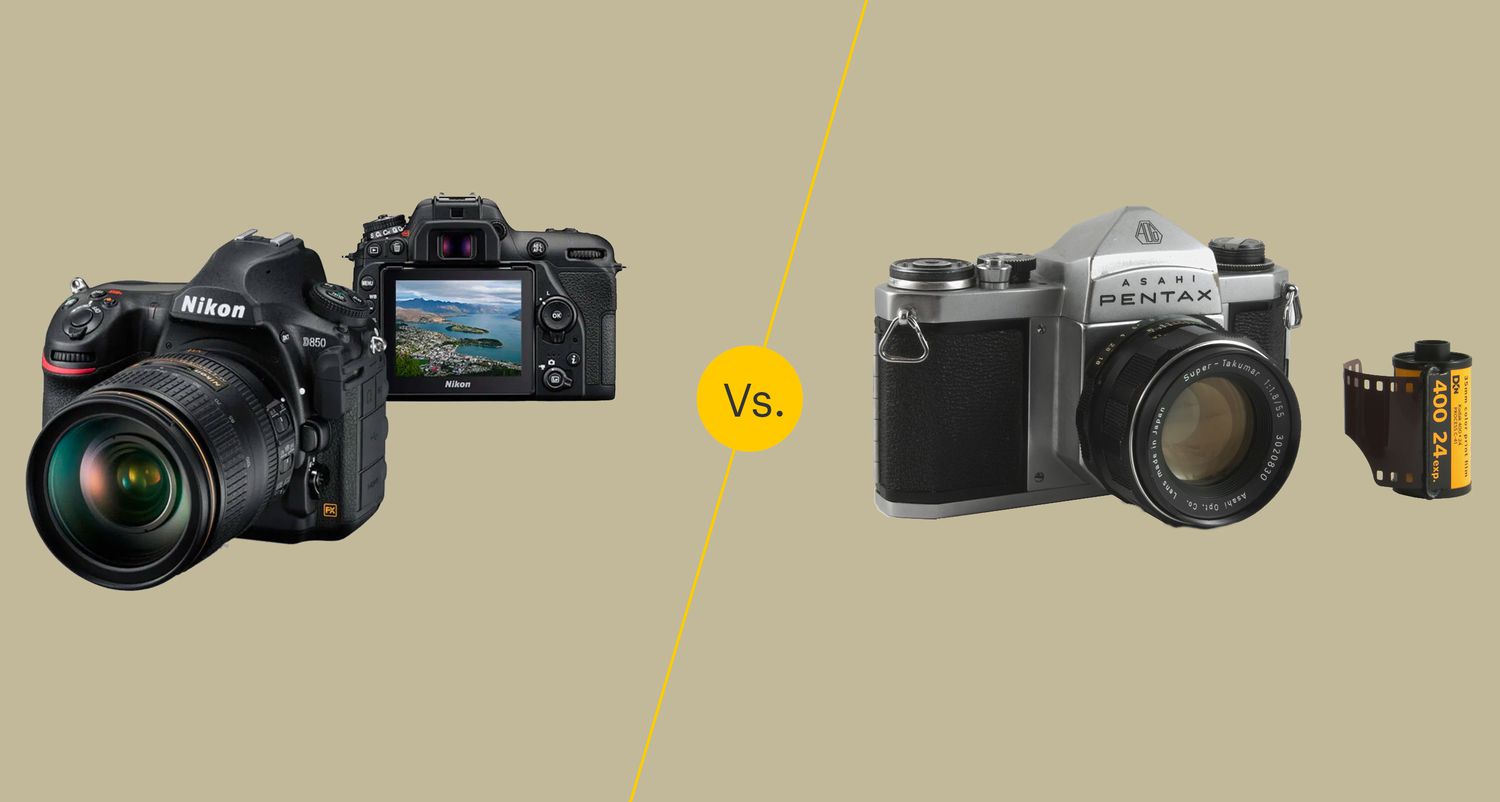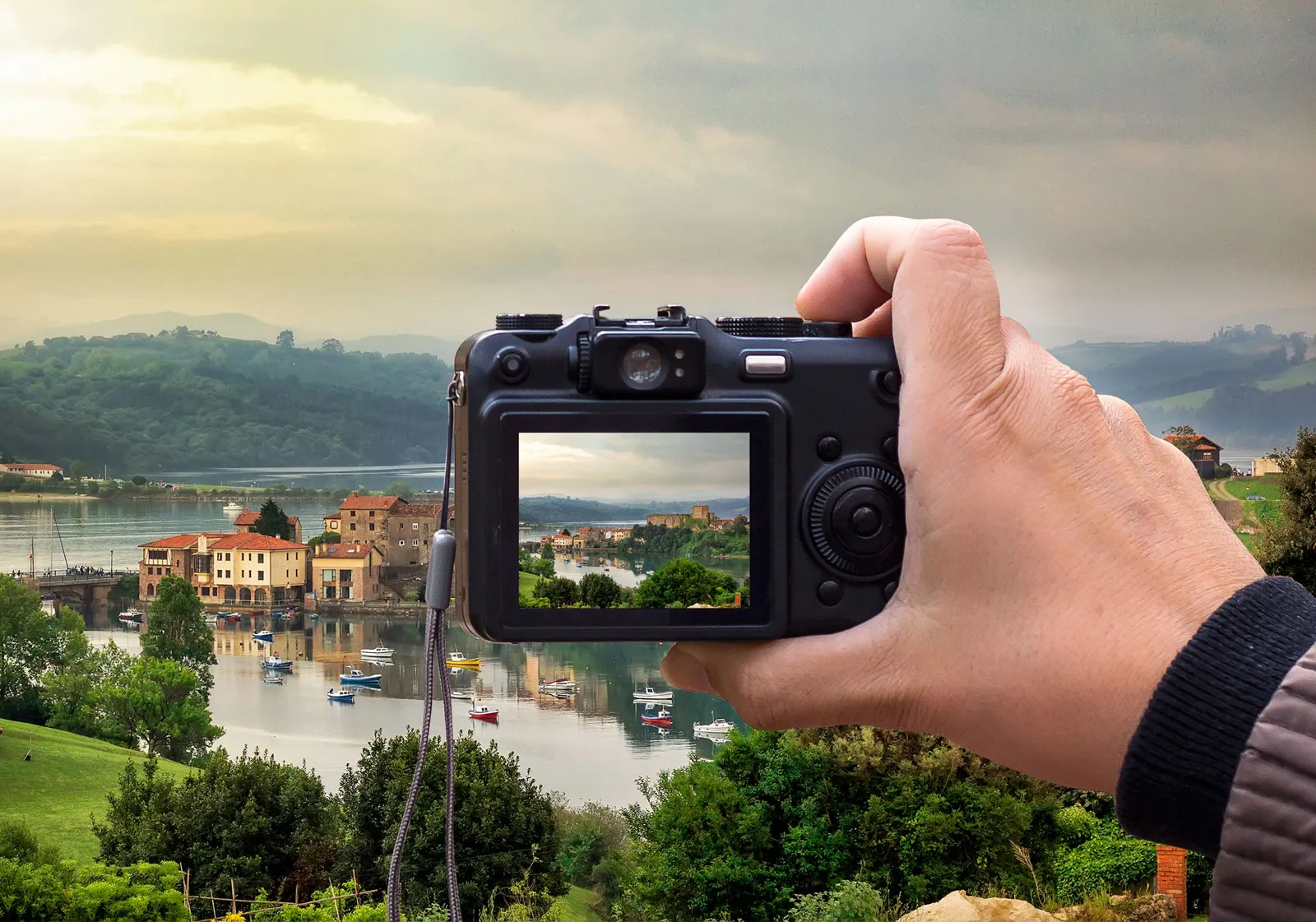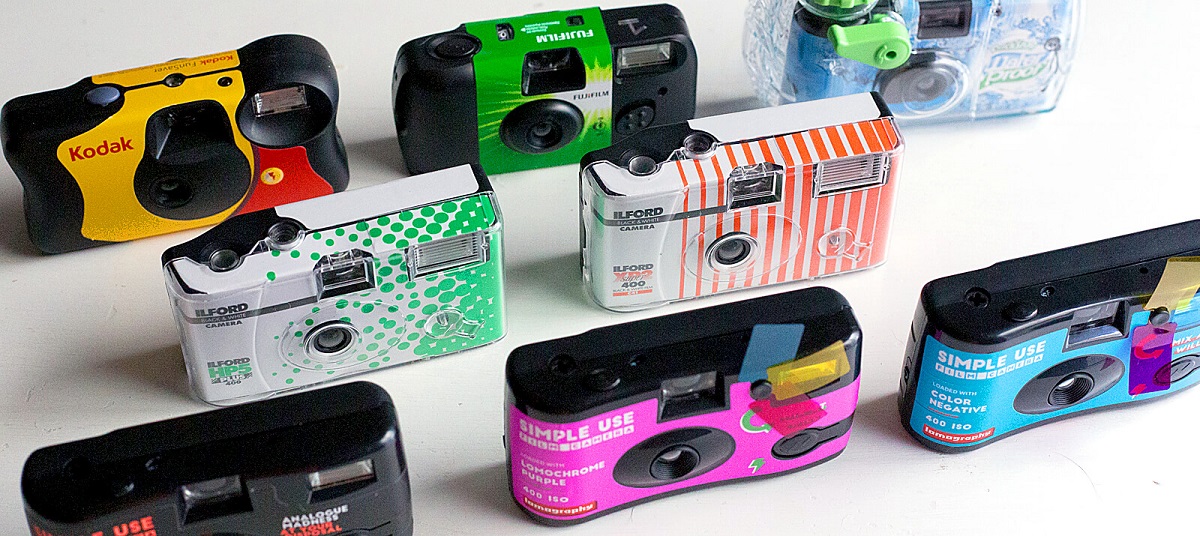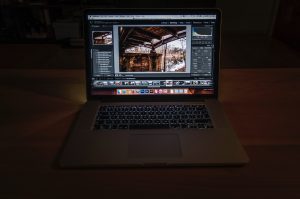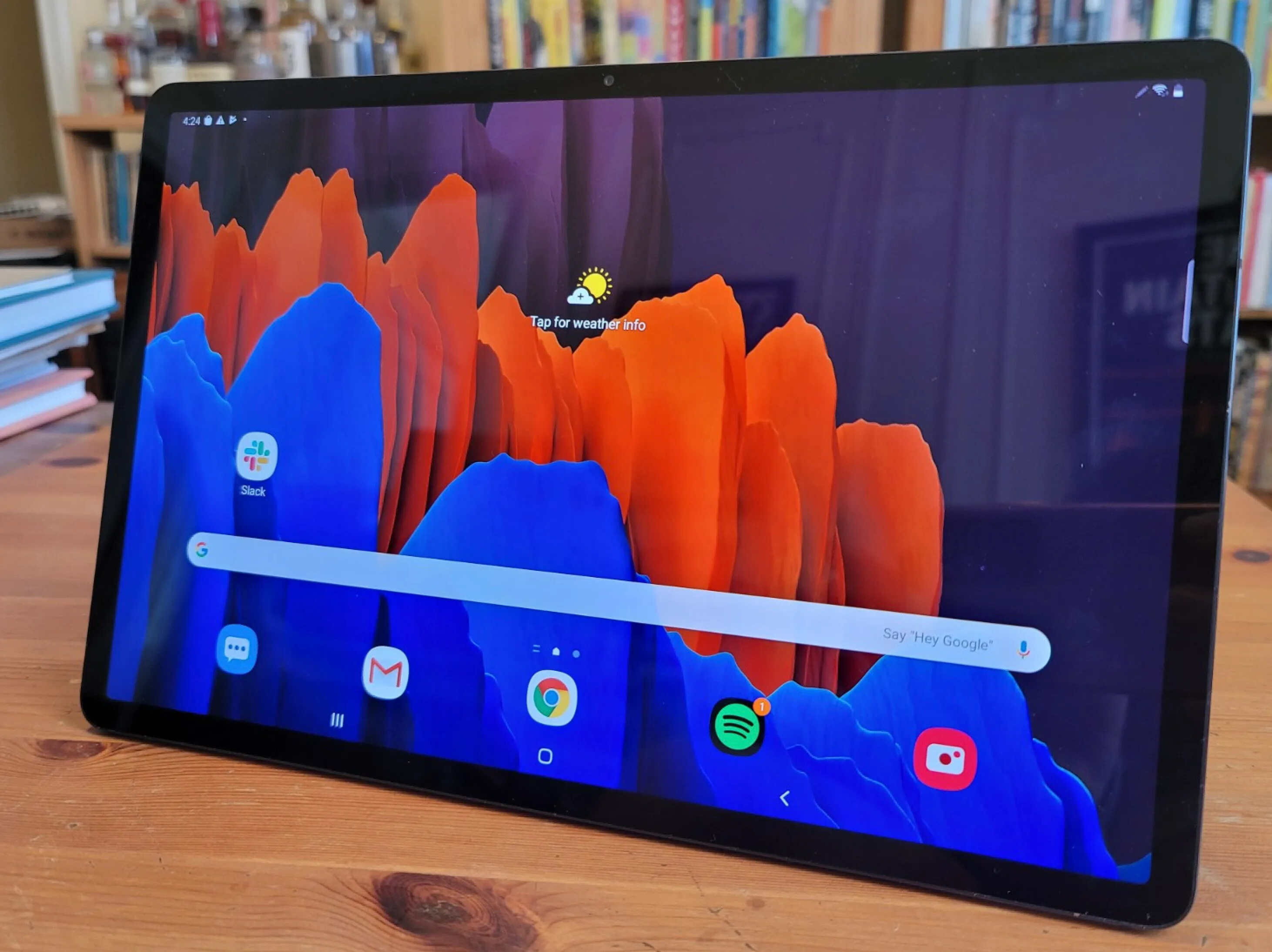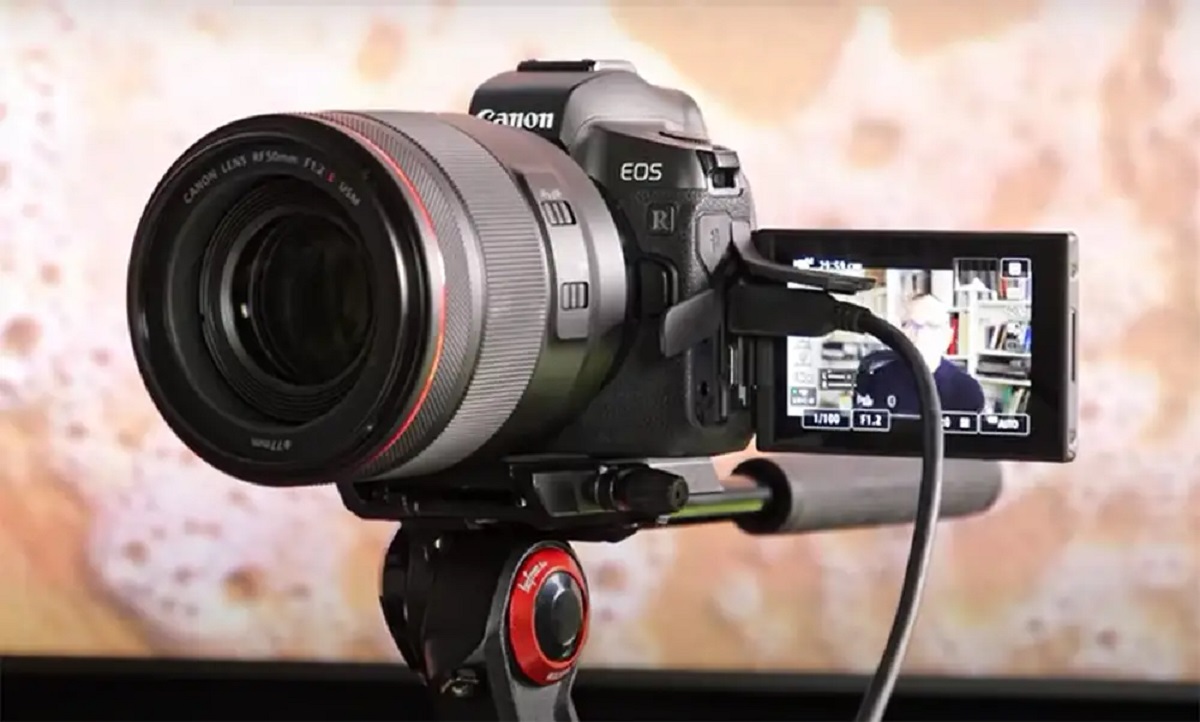Introduction
When it comes to capturing images, there are two main types of cameras we commonly use: film cameras and digital cameras. While both serve the same purpose of taking photographs, there are significant differences between the two. Understanding these distinctions can help you make an informed decision about which camera is best suited for your needs. In this article, we will explore the biggest differences between film cameras and digital cameras, considering factors such as image capture, sensor technology, image quality, speed and efficiency, editing capabilities, as well as cost and convenience.
Film cameras were once the go-to choice for professional photographers and enthusiasts alike. These cameras utilize photographic film to capture images, which requires developing and processing before the images can be viewed. On the other hand, digital cameras utilize electronic image sensors to capture and store images digitally, eliminating the need for film and allowing for instant image preview and sharing.
One of the primary distinctions between film and digital cameras lies in the way they capture images. Film cameras use a chemical process to expose the film to light, resulting in a physical negative. This negative is then developed into a positive print through a series of chemical reactions. In contrast, digital cameras convert light into electronic signals through an image sensor, which are then processed and stored as digital files. This fundamental difference in the image capture process greatly impacts various aspects of photography.
In terms of sensor technology, film cameras use a film strip coated with light-sensitive chemicals, while digital cameras employ either a CCD (charge-coupled device) or CMOS (complementary metal-oxide-semiconductor) sensor. These sensors are responsible for capturing and converting light into digital data. CCD sensors tend to offer higher image quality and better performance in low light conditions, while CMOS sensors excel in noise reduction and power efficiency.
The difference in image quality between film and digital cameras is a subject of debate. Film cameras are often praised for producing a unique, organic aesthetic, with rich colors and a distinctive grain. Digital cameras, on the other hand, offer sharper images with higher resolution and the ability to adjust settings such as white balance and saturation. The choice between the two depends on personal preference and the desired aesthetic for the final images.
Image Capture
When it comes to capturing images, the process differs significantly between film cameras and digital cameras. Film cameras capture images using a chemical process, while digital cameras do so using electronic sensors. Let’s explore how each of these methods works and how they impact the overall image capture experience.
Film cameras rely on photographic film to capture images. The film is coated with light-sensitive chemicals that react when exposed to light. When you press the shutter button on a film camera, a small opening allows light to enter and expose the film. This process creates a latent image on the film, which needs to be developed and processed before the image becomes visible. Film photography often involves manual focus, exposure, and other settings, allowing for precise control over the image capture process.
On the other hand, digital cameras use electronic image sensors to capture images. There are two types of sensors commonly used in digital cameras: CCD (charge-coupled device) and CMOS (complementary metal-oxide-semiconductor). These sensors convert incoming light into electrical signals, which are then processed and stored as digital data. When you press the shutter button on a digital camera, the image sensor captures the scene, and the camera’s processor converts the data into a digital image file. The image can then be instantly previewed on the camera’s LCD screen, eliminating the need to wait for film development.
The image capture process of film cameras and digital cameras has distinct characteristics. Film photography offers a sense of anticipation and a more deliberate approach to capturing images. With limited exposure on a roll of film, photographers carefully consider their composition and settings before pressing the shutter button. The delayed gratification of seeing the developed images adds to the excitement and surprise of the final results.
Digital cameras, on the other hand, provide instant feedback and the ability to review and adjust settings on the fly. This immediate feedback allows photographers to experiment more freely and make adjustments to exposure, focus, and composition in real-time. The digital format also offers the convenience of instantly sharing images with others, whether it be through social media or digital platforms.
Both film cameras and digital cameras have their unique advantages and charm when it comes to image capture. Film photography emphasizes patience, intentionality, and a tactile experience. Digital photography, on the other hand, offers immediacy, flexibility, and the ability to experiment and iterate. Ultimately, the choice between the two methods depends on personal preference, the desired outcome, and the specific shooting conditions.
Sensor Technology
When it comes to capturing images, the sensor technology used in cameras plays a crucial role in determining the quality and performance of the resulting photographs. Both film cameras and digital cameras employ different sensor technologies, which significantly impact the image capture process. Let’s delve into the sensor technology used in each type of camera and how it affects the overall photography experience.
Film cameras do not have electronic sensors like digital cameras. Instead, they use a roll of photographic film coated with light-sensitive chemicals. When light enters the camera through the lens and shutter, it interacts with the chemicals on the film, creating a latent image. This image can then be developed and processed in a darkroom using specific chemicals and techniques. The film’s characteristics, such as the grain structure and sensitivity, play a vital role in the final image quality and aesthetic.
Digital cameras, on the other hand, utilize electronic image sensors to capture and convert light into digital signals. There are two predominant types of image sensors: CCD (charge-coupled device) and CMOS (complementary metal-oxide-semiconductor). CCD sensors use a complex arrangement of capacitors to capture light and convert it into electrical charges. These charges are then read out by the camera’s processor and converted into a digital image file. CCD sensors are known for their excellent image quality and sensitivity to light, making them ideal for low-light photography.
CMOS sensors, on the other hand, use a different technology where each pixel has its own electronic circuitry. This allows for faster image capture and processing but may result in more noise in the image. However, modern CMOS sensors have made significant advancements in noise reduction and offer impressive image quality. CMOS sensors generally consume less power than CCD sensors and are commonly found in most digital cameras on the market today.
The choice between CCD and CMOS sensors depends on various factors, such as the image quality required, the shooting conditions, and personal preferences. CCD sensors tend to perform better in low-light situations due to their enhanced sensitivity to light. They offer less noise, better dynamic range, and high color accuracy. On the other hand, CMOS sensors are known for their power efficiency, faster image capture, and improved noise reduction capabilities. They are also more cost-effective to manufacture, making them the preferred choice for most digital cameras.
The advancements in sensor technology have revolutionized digital photography, providing photographers with greater control and flexibility in capturing images. The sensors’ capabilities, combined with other factors such as lens quality and image processing algorithms, contribute to the overall image quality and performance of digital cameras. Whether it is the distinct aesthetic and process of film photography or the advanced capabilities of digital sensors, both sensor technologies offer unique benefits and cater to different photographers’ preferences and needs.
Image Quality
Image quality is a crucial factor to consider when choosing between a film camera and a digital camera. Both types of cameras offer unique characteristics and aesthetics, each producing images with distinct qualities. Let’s explore the differences in image quality between film and digital cameras and how they can impact your photography.
Film photography is often cherished for its distinct and nostalgic image quality. Film cameras capture images on photographic film, which has its own unique characteristics, including color reproduction, dynamic range, and grain structure. The chemical process involved in developing the film contributes to the organic and timeless look that film photography enthusiasts adore. The film’s grain structure adds a certain charm to the images, while the color response can create a more natural and subtle tone. Film photography also tends to have a greater dynamic range, capturing a wider range of highlights and shadows.
On the other hand, digital cameras offer their own advantages in terms of image quality. Digital cameras produce sharp, crisp images with high resolution, allowing for fine details to be captured accurately. With digital technology, photographers have greater control over various settings, such as ISO (sensitivity to light), white balance, and image parameters like contrast and saturation. This flexibility enables photographers to adjust and fine-tune the image quality during the capture process and post-production. Digital cameras also provide the option to instantly review the images and make necessary adjustments before continuing the shoot, ensuring better accuracy in exposure and focus.
While film photography may offer a unique and appealing aesthetic, it has its limitations. Film grain, which is often seen as a desirable characteristic, can sometimes be unwanted in certain situations, particularly when shooting in low light. Additionally, the need to develop and process film can introduce the possibility of errors or inconsistencies, affecting the final image quality. Digital cameras, on the other hand, offer instant feedback, allowing photographers to quickly assess the image quality and make adjustments if necessary. With digital post-processing tools, photographers have the ability to refine and enhance their images further, ensuring optimal image quality.
The perception of image quality is subjective and can vary based on personal preferences and the desired outcome. Some photographers gravitate towards the tactile and artistic process of film photography, appreciating its unique and authentic look. Others prefer the control, convenience, and flexibility provided by digital cameras, enabling them to achieve precise image quality tailored to their vision. Ultimately, deciding between film and digital cameras’ image quality is a matter of personal preference, artistic style, and the intended use of the photographs.
ISO Range
ISO is a crucial aspect of photography that determines the sensitivity of the camera’s image sensor or film to light. It plays a significant role in capturing images in various lighting conditions. Both film cameras and digital cameras have different ISO capabilities, which can greatly impact the quality and versatility of your photography. Let’s explore the ISO range of film cameras and digital cameras and how they affect image capture.
In film photography, ISO refers to the sensitivity of the film to light. Different films have different ISO ratings, indicating their light sensitivity. Films with lower ISO ratings, such as ISO 100 or ISO 200, are less sensitive to light and are ideal for shooting in bright conditions. These films produce images with finer grain and better overall image quality. On the other hand, films with higher ISO ratings, such as ISO 800 or ISO 1600, are more sensitive to light and are suitable for low-light situations. However, higher ISO films tend to have a coarser grain structure and potentially lower overall image quality.
In the digital realm, ISO refers to the sensitivity of the image sensor. Digital cameras have a wide ISO range, allowing photographers to adjust the sensitivity to suit different lighting conditions. Lower ISO values, such as ISO 100 or ISO 200, produce crisp, noise-free images in well-lit environments. As the ISO is increased, the sensor becomes more sensitive to light, making it easier to capture images in low-light situations. However, higher ISO settings introduce digital noise or grain, which can result in a loss of image detail and overall image quality.
Advancements in digital camera technology have significantly improved the ISO performance of digital sensors. Many modern digital cameras can achieve high ISO settings with minimal noise, allowing photographers to capture usable images even in challenging lighting conditions. This flexibility opens up new possibilities for low-light photography, eliminating the need for external lighting or tripods in some situations.
It’s important to note that while increasing the ISO sensitivity can help capture images in low light, it’s generally advisable to use the lowest possible ISO setting for optimal image quality. Higher ISO values should be used judiciously, keeping in mind the trade-off between image quality and the need to capture a properly exposed image. Additionally, noise reduction techniques and post-processing software can help mitigate the negative effects of noise in digital photographs.
The ISO range of film cameras and digital cameras is a critical consideration when choosing the right camera for your needs. Film photography enthusiasts may appreciate the unique look and characteristics of different films at various ISO ratings. Digital photographers, on the other hand, benefit from the extensive ISO range of digital cameras, providing greater flexibility in capturing images in diverse lighting conditions.
Dynamic Range
Dynamic range is a vital aspect of photography that refers to the range of light intensity a camera can capture, from the darkest shadows to the brightest highlights. It is an essential consideration when comparing the capabilities of film cameras and digital cameras, as it directly affects the level of detail and tonal range in your photographs. Let’s delve into the dynamic range of both film cameras and digital cameras and how it impacts your photography.
Film cameras have long been known for their excellent dynamic range capabilities. Film’s inherent characteristic allows it to capture a wide range of tones and details in a single exposure. This means that film can retain both highlight and shadow detail effectively, producing images with rich tonal gradations. The chemical process involved in developing film further enhances the dynamic range, bringing out subtle details in highlights and shadows.
In contrast, digital cameras have made significant advancements in dynamic range over the years but may still lag behind film in this aspect. Digital cameras use electronic image sensors that have a limited dynamic range compared to film. However, modern digital cameras often employ advanced sensor technology and image processing algorithms to increase their dynamic range capabilities. This allows for better retention of details in both highlight and shadow areas of the image.
The dynamic range of a digital camera is often expressed in terms of stops. A “stop” refers to a doubling or halving of the amount of light. Consequently, a camera with a wider dynamic range can capture more stops of light, resulting in better detail preservation across various lighting conditions. Having a broader dynamic range gives photographers the flexibility to capture scenes with high contrast, such as landscapes with bright skies and dark foregrounds, without losing important details in either region.
It is important to note that capturing the full dynamic range of a scene can sometimes be challenging, especially in high-contrast situations. This is where advanced techniques like bracketing, HDR (High Dynamic Range) imaging, and post-processing come into play. These methods allow photographers to capture multiple exposures and combine them to create an image that encompasses the full range of tones and details.
The dynamic range capabilities of both film cameras and digital cameras have their merits and limitations. Film cameras often excel in retaining details across a wide dynamic range and are particularly favored by photographers working with high-contrast scenes. Digital cameras, while offering relatively narrower dynamic range, benefit from features like built-in metering systems and advanced image processing algorithms, allowing photographers to optimize dynamic range capture and enhance images during post-processing.
Ultimately, understanding the dynamic range capabilities of your camera, whether film or digital, empowers you to make informed decisions about exposure and post-processing techniques. By effectively managing dynamic range, you can create visually stunning images with a balanced distribution of tones and maximum detail retention.
Speed and Efficiency
When it comes to capturing images quickly and efficiently, speed is a crucial factor to consider. Both film cameras and digital cameras offer different levels of speed and efficiency in various aspects of the photography process. Let’s explore the differences in speed and efficiency between these two types of cameras and how they can impact your photography experience.
Film cameras have a more deliberate and time-consuming process when it comes to capturing and producing images. With film photography, you need to load the film into the camera, manually advance the film after each exposure, and eventually rewind the film once it’s fully exposed. Additionally, once the film is complete, it needs to be developed and processed before the images can be viewed. This entire workflow requires more time, effort, and resources compared to digital cameras.
On the other hand, digital cameras offer instant results and greater efficiency. Digital cameras allow for immediate image review on the camera’s LCD screen, providing instant feedback on exposure, focus, and composition. This enables photographers to make adjustments and capture the desired image more efficiently. With digital cameras, there’s no need for film loading or developing, saving both time and money. The images can be easily transferred to a computer or other devices for immediate viewing and sharing.
Digital cameras also offer faster shooting speeds, which can be advantageous when capturing fast-paced subjects or action sequences. Digital cameras typically have burst modes that allow for continuous shooting at high speeds, ensuring you don’t miss critical moments. These cameras also have faster autofocus systems compared to most film cameras, ensuring sharper and more precise focus in various shooting conditions.
In terms of post-processing, digital cameras provide greater efficiency with instant access to digital files. Digital images can be easily edited, retouched, and enhanced using software without the need for physical darkroom processes and chemicals. This flexibility allows photographers to have more creative control over their images and make adjustments to improve the overall quality.
In summary, digital cameras offer unparalleled speed and efficiency compared to film cameras. They provide instant results, faster shooting speeds, and immediate image review. The flexibility of digital files and the ability to edit images digitally contribute to a more efficient workflow, saving both time and resources.
However, it’s essential to note that some photographers still prefer the deliberate and tactile experience of working with a film camera. Film photography encourages mindfulness, patience, and precision in capturing each frame, which can lead to a more deliberate and thoughtful approach to photography.
Ultimately, the choice between film cameras and digital cameras depends on your personal preferences, shooting style, and the specific requirements of your photography projects. Both types of cameras offer unique advantages and drawbacks. The speed and efficiency of digital cameras make them preferred by many photographers for their convenience and ability to capture and share images in real-time.
File Format
The file format in which images are captured and stored is an important consideration for photographers. Both film cameras and digital cameras utilize different file formats that determine how images are recorded and processed. Understanding the differences in file formats is essential in selecting the right camera for your needs and optimizing your workflow. Let’s explore the file formats used in film cameras and digital cameras and how they can impact your photography process.
Film cameras capture images on photographic film, which is a physical medium. The images are recorded directly on the film’s emulsion, which consists of light-sensitive chemicals. The developed negatives can be scanned or printed to produce digitized versions of the images. This process preserves the archival quality of the photographs and provides the opportunity for high-resolution scans for digital sharing and reproduction. Film formats can vary depending on the camera used, such as 35mm, medium format, or large format film, offering different levels of detail and image size.
Digital cameras, on the other hand, capture and store images electronically, resulting in various digital file formats. The most commonly used file formats for digital images are JPEG, RAW, and TIFF. JPEG (Joint Photographic Experts Group) is a compressed format that reduces file size by sacrificing some image quality. It is ideal for everyday photography and sharing images online due to its smaller file size. RAW files, on the other hand, contain unprocessed and uncompressed data captured directly from the camera’s sensor. This format provides the highest level of flexibility and control in post-processing, as it preserves the original image information without any loss or compression. TIFF (Tagged Image File Format) is a lossless format that maintains image quality while offering high compatibility and versatility for professional use.
Each file format has its own advantages and considerations. JPEG files are widely supported and compatible with most devices and software applications. They are smaller in size and require less storage space. However, JPEG is a compressed format, leading to some loss of image detail and quality. RAW files, on the other hand, provide photographers with the most flexibility in post-processing. They offer greater control over adjustments such as exposure, white balance, and sharpening. RAW files capture all the data directly from the camera’s sensor, resulting in higher potential image quality. However, RAW files require post-processing and editing before they can be shared or used in various media.
The choice of file format depends on your specific needs and workflow. For casual use and sharing images online, JPEG offers convenience and smaller file sizes. Professional photographers and those who require maximum control and flexibility often opt for shooting in RAW format, despite the larger file sizes and the need for post-processing. TIFF files are typically used in situations where lossless image quality and compatibility are of utmost importance, such as high-end print production or archival purposes.
It’s essential to consider the advantages and limitations of each file format when choosing a camera or selecting the appropriate format for a specific project. Understanding the strengths and weaknesses of different file formats allows you to make informed decisions and maximize the image quality and usability of your photographs.
Editing and Post-Processing
Editing and post-processing are integral parts of the modern photography workflow. Both film cameras and digital cameras offer different opportunities and considerations when it comes to editing and enhancing your photographs. Understanding how each medium handles editing and post-processing can help you make informed decisions about the tools and techniques you can employ to bring your vision to life. Let’s explore the editing and post-processing aspects of both film cameras and digital cameras.
Film photography involves a physical development and printing process that allows for creative manipulation in the darkroom. During development, photographers can adjust various parameters such as exposure, contrast, and color balance to achieve desired effects. Techniques such as dodging and burning can be used to selectively lighten or darken specific areas of the image. Additionally, film photographers have the freedom to experiment with various printing papers, toners, and chemical processes, resulting in unique and artistic interpretations of their images. However, it’s important to note that the editing process in film photography requires a certain level of skill, knowledge, and access to a darkroom facility.
Digital cameras have revolutionized the editing and post-processing landscape, offering photographers unprecedented control and creative possibilities. With digital images, you can work with a range of software applications, such as Adobe Photoshop and Lightroom, that provide extensive editing tools and capabilities. These applications allow for adjustments in exposure, color balance, contrast, and more. Digital files, especially RAW files, retain a higher level of image data and allow for non-destructive editing, meaning you can make changes to your images without permanently altering the original file.
One significant advantage of digital cameras is the ability to review and preview images instantly on the camera’s LCD screen. This allows photographers to make immediate decisions about exposure, composition, and settings before continuing with the shoot. This preview functionality, combined with the flexibility of digital files, provides a more efficient and iterative process for achieving the desired outcome.
Digital post-processing also offers a wide range of creative options. Photographers can experiment with various presets and filters to achieve different looks and styles. They can selectively adjust specific areas of an image using tools like layers and masks. This level of precision and control opens up new possibilities for creativity and expression.
While digital cameras offer more flexibility and convenience in editing and post-processing, film photographers argue that the hands-on nature of working with physical negatives and prints provides a unique and tactile experience. The unpredictability and serendipity of film photography can produce unexpected and artistic results that are difficult to replicate digitally.
Ultimately, the choice between film cameras and digital cameras for editing and post-processing depends on your preferences, creative vision, and level of expertise. Both mediums offer opportunities for artistic expression and the ability to enhance and refine your images. Whether you prefer the traditional darkroom techniques of film photography or the limitless possibilities of digital editing, refining your post-processing skills can help you elevate your photography to new heights.
Cost and Convenience
When considering a camera for your photography endeavors, it is important to take into account both the cost and the convenience associated with the chosen medium. Film cameras and digital cameras differ in terms of upfront costs, ongoing expenses, and the convenience they offer. Let’s explore the cost and convenience aspects of both film cameras and digital cameras, helping you make an informed decision based on your priorities and budget.
Film photography entails various costs, starting with the initial purchase of a film camera. The prices of film cameras can vary widely, depending on the brand, model, and features. In addition, you need to factor in the ongoing cost of purchasing film rolls, which can range from a few dollars per roll to significantly more for specialty or professional-grade films. Developing and processing the film is an additional expense, as you need to pay for the chemicals and services provided by a professional lab or invest in your own darkroom equipment. These costs can add up over time, particularly if you shoot frequently or require large quantities of film.
On the other hand, digital cameras have become increasingly accessible and affordable in recent years. With a wide range of options available, you can find digital cameras that fit various budgets and requirements. The upfront cost of a digital camera typically includes the body, lenses, memory cards, and possibly additional accessories. However, once you have a digital camera, the ongoing costs are relatively minimal. In most cases, you only need to pay for electricity to charge the camera’s battery and potentially upgrade or purchase new lenses and storage media in the future. Additionally, digital cameras offer the convenience of instant image review and sharing, eliminating the need for film development and scanning costs.
Another point to consider is the convenience factor. Film photography requires careful planning and consideration before each shot. You need to load the film, manually advance it after each exposure, and keep track of the number of frames remaining. This process may limit your ability to capture spontaneous or fast-paced moments. Additionally, the need for film development and the wait time for processing can delay your ability to share or enjoy your photographs. On the other hand, digital cameras offer immediate image review on the camera’s LCD screen, allowing you to assess and adjust settings on the spot. You can also easily transfer digital files to a computer for editing or printing, streamlining your workflow and enabling quick sharing on social media or online platforms.
There are unique benefits and trade-offs associated with both film cameras and digital cameras in terms of cost and convenience. Film cameras may have higher upfront costs and ongoing expenses, but they offer a tactile experience and a distinct aesthetic that many photographers value. Digital cameras, while generally more affordable and convenient, provide immediate feedback, flexibility in editing, and the ability to share images effortlessly. Ultimately, your decision should be based on your budget, preferences, shooting style, and the specific requirements of your photography projects.
Conclusion
In conclusion, the choice between a film camera and a digital camera boils down to personal preferences, shooting style, and the specific requirements of your photography projects. Both types of cameras offer distinct advantages and considerations that can greatly impact your image capture process, image quality, editing capabilities, and overall experience as a photographer.
Film cameras provide a tangible and artistic approach to photography, with their unique aesthetic, hands-on process, and ability to capture images on physical negatives. Film photography appeals to those who appreciate the tactile experience and the unpredictable nature of working with analog mediums. It also offers a wide range of film stocks with different characteristics, allowing for creative exploration and experimentation.
On the other hand, digital cameras provide convenience, flexibility, and opportunities for immediate feedback. They offer features such as instant image review, high-speed shooting, extensive editing possibilities, and easy sharing of digital files. Digital technology has significantly advanced over the years, providing excellent image quality, wide dynamic range, and low-light performance in compact and user-friendly camera systems.
Considerations such as image capture methods, sensor technology, image quality, ISO range, dynamic range, speed and efficiency, file format options, editing capabilities, cost, and convenience all come into play when choosing the right camera. It is essential to assess your priorities, shooting preferences, and budget to determine which camera type aligns best with your needs.
Ultimately, there is no single “best” choice when it comes to film cameras versus digital cameras. Each has its own strengths and limitations, and many photographers find joy and fulfillment in exploring both mediums for different purposes and projects. The decision can also be influenced by the type of photography you pursue, whether it is street, landscape, portrait, or any other genre.
Whatever camera medium you choose, it’s important to continually develop your skills and knowledge to improve your craft. Experimentation, practice, and a deep understanding of your equipment will ultimately lead to capturing the images you envision, regardless of whether they are taken with a film camera or a digital camera.







